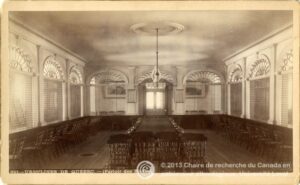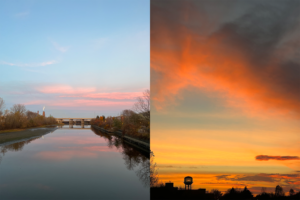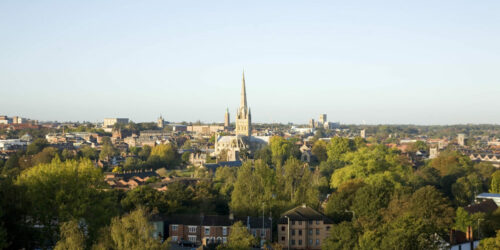
NCW virtual resident Juliette Bernatchez unfolds Québec City history, as they wander past the little river, or Akiawenrahk, and then through the streets of Old Québec.
Walking with historian Sophie Imbeault, Juliette Bernatchez discusses the history and landscape of our fellow UNESCO City of Literature Québec. She particularly focusses on histories of monasteries, and the power beholden to the Ursulines. The walk begins and ends with the river, winding through their conversation on Québec old and new.
This virtual residency exchange was made possible with the support of the Québec Government Office in London and l’Entente de développement culturel entre le gouvernement du Québec et la Ville de Québec. Click here for the French webpage on the residency exchange.
little river
By Juliette Bernatchez
Trans. Claire Gullander-Drolet
On the bus ride shuttling me to my meeting with historian Sophie Imbeault, a brilliant sun casts its rays, bright and imposing, through the windows. Though the leaves have fallen and the greying has returned, it’s another one of those unseasonably warm November days.
Sophie and I walked and talked about Québec City history for several hours. Of fortifications, the two enclosed monasteries, the Seven Years’ War, the Battle of the Plains of Abraham. I learned that in 1759, Montcalm believed that the English would burst into New France via the Saint-Charles river, which borders Limoilou, where I live. I came to realize, then, that the river was an important vehicle for the economy under the French regime.
There are days I pass the little river without even noticing she’s there.
Ever since the seventeenth century, we’ve called it petite rivière—“little river”—or by its Wendat name, Akiawenrahk, which means “river of trout.” It’s important to know that Québec City is situated on the ancestral and unceded lands of the Wendat and Abenaki peoples. The little river begins at the Saint-Charles lake and descends all the way to the Saint-Lawrence river while passing Wendake, or the Kabir Kouba falls, famous for its breathtaking rapids and cascades. When the river reaches Limoilou, though, she becomes drier, sadder. This is because we treated it like a dump during the industrial era, emptying the city sewers into it, as well as runoff from the surrounding factories. My parents told me that they used to skate on its frozen banks during the winter. In an archival photo that dates to 1978, one can see dozens of brightly-colored skaters peppering the ice. It was only in 1998 that winters were deemed too unpredictable for safe river skating. From that point on, the banks were embellished with a thirty-odd kilometer linear park, replete with footpaths and cross-country ski tracks.
There are days I pass the little river without even noticing she’s there.
*
Arriving in the upper city, Sophie and I walked the streets of Old Québec, along rue Saint-Jean, past rue Couillard all the way to rue des Remparts. The historical home of Montcalm can be found on this street, converted into luxury condos. The view of what remains of the fortifications and basse-ville is now unobstructed. I say now, because in 1871 the fortifications were cut in half to allow citizens to enjoy a view of the Laurentians. Sophie also told me that during the Seven Years War, no one fought during winter. Officers held balls, wives held salons. Montcalm could fully enjoy his home, and life went on until the thaw.
We followed the rue Saint-Ursule all the way to a dead end street we call ruelle des Ursulines. Since access was blocked, we retreated down rue Saint-Louis to rue des Jardins, finally arriving at the Ursuline Monastery on rue Donnacona. There we sat for more than two hours.
When you find yourself around passionate people, their enthusiasm is contagious, and there is this desire to know who is responsible for the spark in their eye.
Although we had specific discussion points planned for this visit, Sophie and I spoke for a long time about women we admired. Thanks to her, I rediscovered the Chauveau sisters and learned of Esther Wheelwright, a woman whose fate took my breath away. When you find yourself around passionate people, their enthusiasm is contagious, and there is this desire to know who is responsible for the spark in their eye.

On this bench near the monastery, Sophie spoke to me about the Ursulines. Of Montcalm’s skull, displayed in a little box until 2001, and how this glorious relic attracted many curious tourists to the monastery. Of the black veil that the Ursulines wore in front of their faces when they went out to visit, because the sight of their hair, throat, and eyebrows was considered illicit. I learned that when the Ursulines received the order to cloister themselves in 1618, several French congregations threatened to dissolve the community, refusing to accept this fate. They would have to get used to it, however.
We spoke of all the different parts of the monastery. The convent door, through which the devoted entered the cloister and renounced the material world. The inner parlor, described as a transitory space between the private world of the cloister and the public. The stone corridor, built in 1712, which served as a refuge for the nuns during the bombings.


The Ursulines were women of action. In addition to their heavy duties of teaching and ministering to the sick, they were seigneuresses. They owned and oversaw lands up to fifty kilometers away from their monastery at Sainte-Croix. From 1682 to 1923, they participated in colonization and development at a remove. Power was delegated and affairs controlled from the monastery parlor, and they oversaw many acres of land without ever being able to set foot there themselves.
Observing the construction of the Price Building in 1929, the Ursulines readied themselves to black out the windows that looked out onto the garden. With the building being hoisted directly in their courtyard, they were prepared to barricade the windows themselves if necessary. In 2018, after occupying the monastery for 375 years, the majority of the devoted moved to a care home in Beauport. Five Ursulines currently hold symbolic residence in the monastery, without being cloistered.
The prospect of studying in such a stunning building made us yearn for our youth
Sophie and I knew that the afternoon was drawing to a close when we heard the school bell ring and dozens of children spilled out, ready to head home. While the boarding school closed its doors in 1967, the institution itself remained open to girls and became coeducational in 2010. The prospect of studying in such a stunning building made us yearn for our youth—oh to be seven years old again, and gap-toothed!
I returned to basse-ville that day with my heart full, pressing on to Limoilou. Walking back, the sun’s rays shimmered hypnotically on the Saint Charles, almost as though the little river knew that we’d been speaking about her all afternoon. She seemed proud to have re-established her importance, her presence, proud that someone helped me to see things differently.



Juliette Bernatchez has a master’s degree in literary studies and is a cultural worker and author. Since 2018, she has accumulated contracts in several festivals and cultural organizations in Quebec City. In February 2021, she co-founded and co-directed CONTOURS, a literary arts production and distribution organization. As an author, she has performed in various artistic events and can be read in the magazines Zinc, Le Sabord and Françoise Stéréo. In the summer of 2022, she was awarded a creation grant from the Conseil des arts et lettres du Québec to write her first book. Photography by Justine Latour.
You may also like...
‘In the Language Slipstream’ by Crispin Rodrigues
A commission from our 2022 virtual resident on code-switching, speech acts and biracial-bilingual identity

15th February 2023
Norwich in five books
From world-famous writers who have called Norwich home

14th February 2018
Quebec City in five books
Discover the first French speaking UNESCO City of literature

14th February 2018






